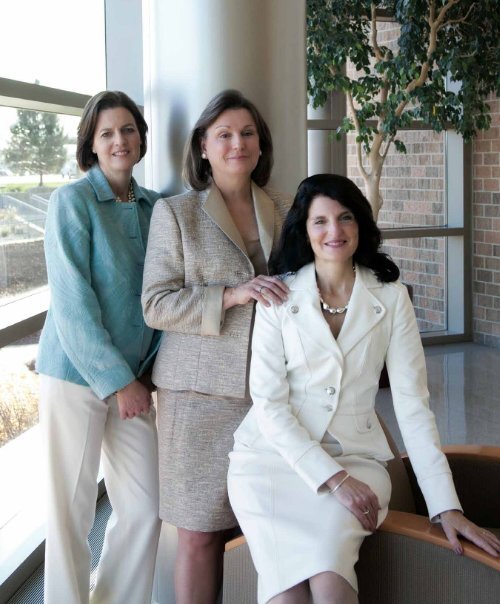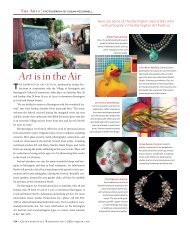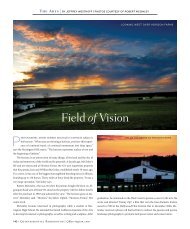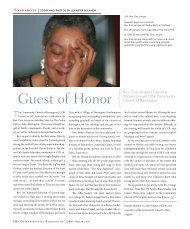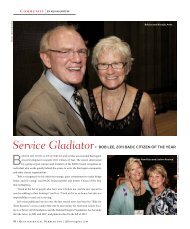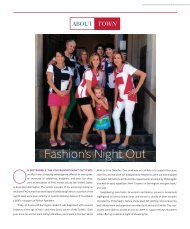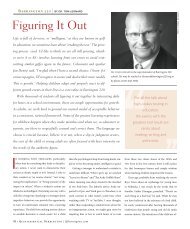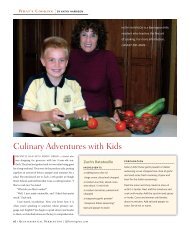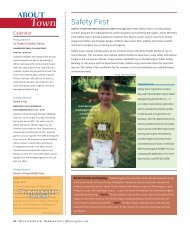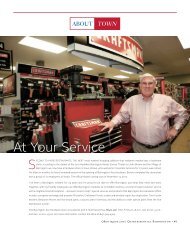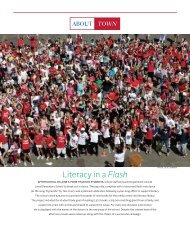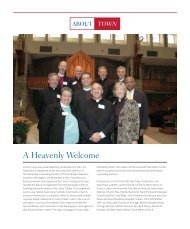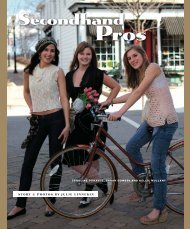The Healthier Barrington - Quintessential Barrington Magazine
The Healthier Barrington - Quintessential Barrington Magazine
The Healthier Barrington - Quintessential Barrington Magazine
Create successful ePaper yourself
Turn your PDF publications into a flip-book with our unique Google optimized e-Paper software.
By Lisa Stamos<br />
Photos by April Graves<br />
<strong>The</strong> Health of a Community<br />
What the <strong>Healthier</strong> <strong>Barrington</strong> Needs Survey<br />
Has Taught Us<br />
<strong>The</strong> <strong>Healthier</strong> <strong>Barrington</strong> Needs Survey has measured various<br />
aspects of our lives for the past 15 years, offering insight about what<br />
we value and what we see as the challenges. <strong>The</strong>re is much to be<br />
learned from this study, but the real story that’s told is one of a<br />
community that listens to its needs and works together to improve<br />
its quality of life.<br />
<strong>Healthier</strong> <strong>Barrington</strong> Coalition partners Karen Lambert,<br />
President of Advocate Good Shepherd Hospital; Leslie<br />
Luther-Jeschke, Executive Director of <strong>Barrington</strong> Area<br />
United Way; and Karen Darch, President of the Village of<br />
<strong>Barrington</strong>.
Advocate Good Shepherd Hospital initiated the <strong>Healthier</strong> <strong>Barrington</strong> Needs<br />
Survey. Karen Lambert, president of the hospital, has provided the support<br />
necessary for the survey’s success, including a dedicated staff person and<br />
funding.<br />
Karen Darch has been involved in the <strong>Healthier</strong> <strong>Barrington</strong> Needs<br />
survey since its inception in 1995.<br />
Advocate Good Shepherd Hospital started the survey as a means to<br />
reach out to the greater <strong>Barrington</strong> area community, and to become<br />
better connected and more aware of the needs of the community. In<br />
their commitment, they hired Sylvia (Syl) Boeder for the role of community<br />
relations. She has been instrumental in all aspects of conducting the survey,<br />
reporting results, and building a coalition of community service organizations<br />
that can respond to the data. Syl is joined by Karen Darch and the researcher,<br />
Joel Cowen, as those of a handful of people who were there from<br />
the start.<br />
<strong>The</strong> <strong>Healthier</strong> <strong>Barrington</strong> Project’s first survey was conducted, and has<br />
since been, through a partnership with the Health Systems Research at the<br />
University of Illinois College of Medicine. <strong>The</strong> survey is the main method for<br />
collecting input and data for the <strong>Healthier</strong> <strong>Barrington</strong> Project. Every three<br />
years, starting in 1996, the survey has reached between 3-4,000 residents<br />
through a random selection, with what is considered a successful outcome<br />
at a 13.1 percent response rate for the 2011 survey. For the 2011 survey, that<br />
represents 524 surveys returned. According to Joel Cowen, the researcher<br />
who has led the survey’s development, that is a response adequate for the<br />
task.<br />
“We wanted 400 survey responses, which assumes a margin of error of<br />
+5/-5 percent. Statistically, this is a successful outcome. After a thousand<br />
responses, you really don’t gain anything — you’re at the point where you’ve<br />
got the right answers,” he said.<br />
Joel also noted that he maps the <strong>Healthier</strong> <strong>Barrington</strong> data against U.S.<br />
Census data to see if there are any biases. “For <strong>Barrington</strong>, the bias does<br />
lean to older people, women, and a better-educated individual,” he noted.<br />
He added that women tend to respond more often to inquiries that involve<br />
human services.<br />
<strong>The</strong> information from the survey was made available to the public through<br />
the Village of <strong>Barrington</strong>’s presentation at a public meeting in the fall. <strong>The</strong><br />
survey is also currently available through the <strong>Barrington</strong> Area Library’s Web<br />
site, at www.barringtonarealibrary.org/community-resources.html.<br />
96 • <strong>Quintessential</strong> <strong>Barrington</strong> | Q<strong>Barrington</strong>.com
<strong>The</strong> <strong>Barrington</strong> Area United Way has supported the <strong>Healthier</strong> <strong>Barrington</strong> Needs Survey since its beginning. Today, Leslie Luther-Jeschke , its executive director, puts<br />
the survey results to work in how BAUW programs are developed and how initiatives are funded.<br />
<strong>The</strong> information collected is directed at a broad spectrum that represents<br />
an overall understanding of the quality of life in the area. <strong>The</strong> main focus is<br />
the community’s sense of what it needs, what it wants, as well as questions<br />
that look into both positive and negative aspects of life here. <strong>The</strong> main theme<br />
that rises to the top – the primary factors that matter most – are the quality<br />
of our schools, living in a peaceful, small town atmosphere, and low levels<br />
of crime. Services related to the school district and local library were rated<br />
highest.<br />
Employment issues — a key theme<br />
According to the 2011 survey, 13.9 percent of households experienced involuntary<br />
job loss during the past year, up from 10.5 percent in 2008. Today, job<br />
losses are the most common within households of respondents aged 45-65.<br />
Unemployed respondents indicated that they did not find the assistance that<br />
they needed to help them locate a job – at a rate of over 44 percent of people<br />
responding who are unemployed.<br />
While the unemployment rate hovers around 10 percent nationally, <strong>Barrington</strong><br />
area residents who responded to the survey report that 19.5% of<br />
households had someone unemployed and looking for work in the past year.<br />
While we were reading this information, on the other end of the unemployment<br />
conversation, we learned that at CareerPlace, a <strong>Barrington</strong>-based<br />
job coaching and support agency, the services are currently under-utilized by<br />
the public. We’ve featured them in this issue to help let people know about<br />
their services, including three current job seekers who shared their stories.<br />
A large shift in employment is that more people are working from home.<br />
In 2011, the percentage was noted at 27.9 percent — almost double what it<br />
was in 1999, when it was measured at 13.4%. <strong>The</strong> <strong>Barrington</strong> Area Chamber<br />
of Commerce is well-aware of this statistic, and is developing its programs<br />
to help support this sector. Extra meeting space, news ways to connect and<br />
network, and services that are geared for the small business are a priority, as<br />
reported in our feature story on the Chamber.<br />
Basic needs in a recession<br />
Another key finding in the 2011 <strong>Healthier</strong> <strong>Barrington</strong> Needs Survey is that<br />
people are putting off health care services because of cost, or had difficulty in<br />
paying their bills – both categories noted at about 20 percent of households.<br />
More than half of all respondents (56.9 percent) noted that they had been<br />
affected financially by the recession through pay cuts and investment losses.<br />
People are spending their dollars more carefully.<br />
Concern for our children<br />
One of the ways in which the <strong>Healthier</strong> <strong>Barrington</strong> coalition works together is<br />
adding new questions, or updating the manner in which questions are asked.<br />
Coalition members share information and network together to continually<br />
Q<strong>Barrington</strong>.com | <strong>Quintessential</strong> <strong>Barrington</strong> • 97
Joel Cowen just retired as the Assistant Dean for Health Systems Research at the<br />
University of Illinois College of Medicine at Rockford. Joel has guided the survey<br />
process since 1995, offering academic excellence in managing the survey, but<br />
also continuity in what he says is a survey with the greatest longitudinal data<br />
in the region.<br />
improve the data collections, especially based on the trends that they see. For<br />
example, a new question was added that asked, “Which of the following are<br />
issues for your child or children under 18?”<br />
Three problems led the list — over-scheduling (10 percent), anxiety and<br />
nervousness (9.4 percent), and attention deficit disorder (9.1 percent). <strong>The</strong><br />
next concerns listed were sleep deprivation (7.5 percent), bullying (6 percent)<br />
and learning disabilities (5.7 percent). Of all respondents, nearly 70 percent of<br />
parents noted one of the above concerns.<br />
Sylvia (Syl) Boeder was hired by Advocate Good Shepherd Hospital to<br />
coordinate the survey and participating coalition members. She began<br />
the project in 1995 and just this year is stepping down, handing her legacy<br />
of building a healthier community in the capable hands of Julie Mayer, who<br />
works for the hospital and will carry on the tradition as an ambassador to<br />
work with the coalition member organizations.<br />
Putting the information to work<br />
Village of <strong>Barrington</strong> president, Karen Darch, has found the surveys to be<br />
very useful through the years. “It allows us to make informed decisions,” she<br />
said. Yet the greatest benefit is in how the coalition partners come together.<br />
“<strong>The</strong> group is cohesive, and comfortable with each other” she said. “<strong>The</strong>y<br />
are cooperative, knowledgeable and able to implement the findings that are<br />
important — and with results.”<br />
<strong>The</strong>re is an enormous amount of information in the 2011 <strong>Healthier</strong><br />
<strong>Barrington</strong> Needs Survey to wade through and put to work. Coalition members<br />
are looking to take the relationships they’ve built and create a system<br />
that makes it easier for residents to find the help they need in social services<br />
and the many areas that together make up a better quality of life.<br />
It’s impressive that the <strong>Healthier</strong> <strong>Barrington</strong> project is still going — and<br />
that its members are even looking to move their collective efforts to a more<br />
efficient level for the public. Researcher Joel Cowen says that this survey is<br />
the longest-running of its kind in our area. But he is quick to add a personal<br />
perspective.<br />
“<strong>The</strong> heart of this story is not just the longitudinal aspect of the effort and<br />
the data – it’s the collaboration, and the people working together to carry it<br />
forward, getting results. It’s what differentiates <strong>Barrington</strong>.”<br />
98 • <strong>Quintessential</strong> <strong>Barrington</strong> | Q<strong>Barrington</strong>.com
<strong>The</strong> <strong>Healthier</strong> <strong>Barrington</strong><br />
Project Coalition<br />
Partner Organizations<br />
»»<br />
Advocate Good Shepherd Hospital<br />
»»<br />
<strong>Barrington</strong> Area Chamber of Commerce<br />
»»<br />
<strong>Barrington</strong> Area Council on Aging<br />
»»<br />
<strong>Barrington</strong> Area Council of Governments<br />
»»<br />
<strong>Barrington</strong> Area Drug Prevention Coalition<br />
»»<br />
<strong>Barrington</strong> Area Library<br />
»»<br />
<strong>Barrington</strong> Area Safety Council<br />
»»<br />
<strong>Barrington</strong> Area United Way<br />
<strong>Barrington</strong> High School student, Kylie Mena, is working in an internship role with the coalition<br />
this year. Her job is to gather, organize and document data from social service agencies<br />
throughout the greater <strong>Barrington</strong> area. <strong>The</strong> resulting data will be integrated into a<br />
navigation system, whereby individuals seeking assistance can get to the support, help and<br />
resources they need more directly, and quickly.<br />
»»<br />
<strong>Barrington</strong> District 220<br />
»»<br />
<strong>Barrington</strong> Park District<br />
»»<br />
<strong>Barrington</strong> Township<br />
»»<br />
<strong>Barrington</strong> Youth & Family Services<br />
»»<br />
CareerPlace<br />
»»<br />
Citizens for Conservation<br />
»»<br />
Character Counts in <strong>Barrington</strong><br />
»»<br />
Cuba Township<br />
»»<br />
Family Service of the <strong>Barrington</strong> Area<br />
»»<br />
H.E.R.E. in <strong>Barrington</strong><br />
»»<br />
Hospice and Palliative Care of<br />
Northeastern Illinois<br />
»»<br />
Leave No Child Inside<br />
»»<br />
Samaritan Counseling Center of the<br />
Northwest Suburbs<br />
»»<br />
Smart Farm<br />
»»<br />
Village of <strong>Barrington</strong><br />
<strong>The</strong> coalition members of the <strong>Healthier</strong> <strong>Barrington</strong> Project<br />
have learned that citizens may require between five to eight (or even more) contacts<br />
by phone to agencies and service providers before they find one that is a fit. <strong>The</strong>re is<br />
so much to wade through. <strong>The</strong>re are layers of qualifying and general discussion to see<br />
if a particular organization is the right one, and one whose services can be afforded,<br />
and qualified for in terms of where that person lives, and other criteria. This insight<br />
might be the most important information of all. It could be the next evolution for the<br />
coalition.<br />
Coalition members meet on a regular basis to discuss survey findings. A topic at a<br />
meeting in November was the discussion of a possible initiative to address and raise<br />
questions that revolve around how to offer a path to simplify the process for people<br />
who are reaching out for assistance. Also, there is room for greater alignment and<br />
understanding between coalition members in terms of referring people to the right<br />
agency for their needs, hopefully within the first referral.<br />
As the discussion continues into 2012, Julie Mayer, from Advocate Good Shepherd<br />
Hospital, and founding coalition member, Joyce Palmquist of the <strong>Barrington</strong> Area<br />
Council on Aging, spearhead the discussions.<br />
Taking notes is Kylie Mena, a <strong>Barrington</strong> High School student with an eye toward<br />
med school in the years ahead. Kylie is working as an intern for the coalition, contacting<br />
agencies in the surrounding communities, and gathering and organizing data that<br />
may become the basis for an informational “navigation” system of some kind, made<br />
available to the general public once created. It’s a work in progress.<br />
For now, at QB we’ve gathered some of that basic information — a directory of sorts<br />
— that we’ve posted on the homepage of our Web site. We hope it’s the beginning of<br />
something good.<br />
Q<strong>Barrington</strong>.com | <strong>Quintessential</strong> <strong>Barrington</strong> • 99


